In-flight catering plays a crucial role in enhancing the overall experience for passengers and meeting their specific needs. Successful in-flight catering in business aviation demands that chefs and operators possess flexibility and attention to detail. They must be able to effectively coordinate logistics to meet the different requirements and expectations of individual passengers while operating within the constraints of the aircraft and travel schedules.
“I’ve been in the catering world since I was 16 years old,” says Daniel Hulme, CEO of On Air Dining, an in-flight catering business based in London Stansted Airport. “I have experience in high-end hospitality. Catering in aircraft is by far the most complex type of catering.
“When it comes to on-the-ground catering you know where the event is, when it is, and how many people are coming to dinner. But we can’t do that with business aviation. We operate 24 hours a day, seven days a week, just like the operators.”
Time constraints are an obstacle for business aviation caterers. It is a common misconception that orders can be made at 5:00pm the day before a flight and delivered to the aircraft at 11:00am the following day, because clients believe their catering is made just a few hours before.
“There’s no catering company that can do that,” says Hulme. “We tend to get our orders between 24 hours and 12 hours before a flight. When an order comes in we start on it straight away.
“Things like pastries and salad that perish fast are always left until the very last minute to make. Steaks, sauces, and pasta are made around 12 hours before the flight into the night and packed.
“The last thing you want is last minute changes, such as additional or fewer passengers or something that needs to be added to the menu. If things are being done last minute, there is a greater risk the order won’t get to the aircraft at all.”
Ordering ahead
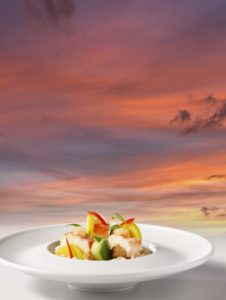
Debbie Georgiou is the fine dining consultant at Bon Soirée, a long-standing private jet catering team founded over 20 years ago that covers airports in London and the South
of England.
Georgiou says, “The notice required for providing catering for a private jet can vary depending on the complexity of the order, and the specific requirements of the clients.
“However, it is most advisable to provide a minimum notice of 24 hours for catering requests for private jets.”
Maria José Lardizabal Arellano, executive chef at Manny’s Catering, a Toluca Airport, Mexico-based business aviation catering company says, “A 24 hour timeframe allows for menu planning, ingredient sourcing, recipe development and any necessary adjustments.
“But, if the menu is particularly complex or requires extensive customization, it is advisable to provide more lead time to ensure a well-crafted and tailored menu.”
Georgiou believes that catering for business and private aviation passengers presents several challenges, but cites limited space and storage as the main issue.
“Business jets have limited galley space and storage capacity compared to commercial aircraft,” she says. “Catering for these jets requires careful planning to ensure that the food, beverages, and necessary equipment can be accommodated within the available space.”
Cabin considerations
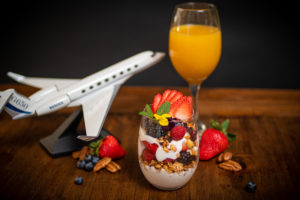
Space isn’t the only issue caterers must contend with when planning a menu that will be eaten up among the clouds.
The combination of altitude, dry cabin air, low humidity, noise, vibrations, cabin pressurization, and meal preparation factors can collectively influence the taste of food during a flight, explains Lardizabal Arellano.
“We are aware of these challenges and often make adjustments to our recipes and meal service to enhance the dining experience on board,” she says.
“People may be quite surprised to know that in a pressurized environment, your sensitivity to both saltiness and sweetness do change,” explains Bon Soirée’s head chef, Mani Martin. “That is why we use caviar to finish off some fish sauces. Not only does it bring in the saltiness that is required but also that luxury feeling.”
There are five basic tastes when it comes to food: sweet, sour, salty, bitter, and umami.
“The only flavor that isn’t affected during flight is umami,” says Martin.
“We look at the science of salt, or umami flavors or how the moisture is affected in the mouth,” explains Hulme.
“A private jet is one of the harshest environments in which to eat food. Moisture in the mouth and nose is vital when you eat so you can taste and smell. Most humidity levels a human experiences are about 20%. Aircraft operate at about five to 10% humidity levels, causing dryness which means you lose the ability to smell. If you can’t smell, you can’t taste.
“So, we looked at the science of umami, the fifth sense of taste discovered by a Japanese food scientist in the 1930s. Umami has the flavor of the back of your mouth that kicks in your saliva glands. It’s why tomato juice and sushi taste so good on an airplane,” he says.
To counter the effect that this highly pressurized environment has on our tastebuds, inflight caterers try and pack in as much umami flavor as possible into the food. “There is a lot of science behind inflight catering,” says Hulme.
Perfect plating
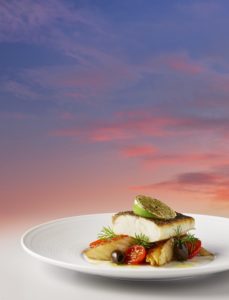
To ensure clients receive an elevated dining experience, ingredients should be high-quality and sourced from reputable suppliers. “Fresh, seasonal, and locally sourced ingredients can enhance the taste and overall experience of the food,” says Lardizabal Arellano.
Martin agrees, “There are several things that we do to elevate the food. The number one and most important is the produce itself. We only use top quality produce from top quality suppliers.
“Some dishes are finished off with caviar, and other dishes are finished off with savoury or sweet tuiles which is very on point now. These elevate a simple looking dish into Michelin standard.”
Private jet passengers often have higher expectations and seek a more personalized dining experience.
“Being creative is key when serving customers and a visually appealing presentation is a key factor for inflight catering,” says Lardizabal Arellano.
The phrase you eat with your eyes first is paramount when it comes to plating and presenting meals on a private jet. Every detail is planned to enhance the consumer’s experience. However, because it is down to flight attendants to make sure the catering chef’s vision is executed, catering companies have different techniques to ensure everything is correct when the meal is placed in front of the passengers.
“We spend a lot of time developing the dishes. So, we make labels with a photograph of these dishes which have clear and precise instructions on how to assemble them,” says Martin.
Some caterers label individual instructions for each course and provide standard operating procedures [SOPs] for flight crews.
Lardizabal Arellano says, “Establishing clear and comprehensive SOPs for food preparation and service is crucial. These SOPs should cover all aspects, including food storage, heating or chilling procedures, plating guidelines, allergen handling, and any specific requirements for different menu items. Flight attendants should be well-versed in these procedures and follow them consistently to ensure safe and efficient service.”
Quality control
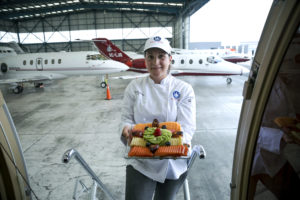
“We use the latest techniques such as sous vide to ensure the food holds its moisture and retains its flavor. The vegetables are cooked al dente, and the sauces and garnishes are packed separately in containers,” explains Martin.
“Maintaining the correct temperature is crucial for preserving the quality and safety of food during its transport. Proper packaging is essential to protect the food from external contaminants and maintain its freshness. Food containers should be leak-proof, airtight, and secure to prevent spills, cross-contamination, or exposure to air,” says Arellano.
Food trends
In-flight catering has not escaped the food trends that we see on the ground. The in-flight catering industry is constantly evolving, and new trends emerge as customer preferences change.
“At present, we are seeing that more passengers ordering lighter meals such as salads. We have also seen a rise in requests for vegetarian, vegan, and plant-based dishes, which are healthier and more eco-friendly.
We have incorporated all of these into our menus,” says Martin.
Lardizabal Arellano agrees, “In recent years, there has been a growing demand for healthier food choices among travelers. Passengers now also expect more control over their dining experience.
“It’s important to stay updated with the latest market research and customer feedback to provide the best possible dining experience.”
Last-minute changes
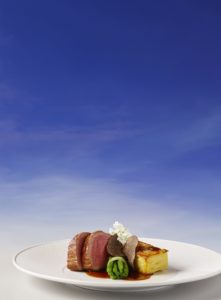
Making last-minute changes to a private jet catering order can be challenging, but it ultimately depends on the specific circumstances. Coordination with flight schedules is vital.
“Private jet itineraries can be dynamic and flight schedules may change at short notice. We are always prepared to adapt and coordinate with the flight crew to ensure that the catering delivery aligns with the updated departure or arrival times. Timely communication and flexibility are crucial in these situations,” says Georgiou.
“While making last-minute changes in business aviation inflight catering can pose challenges, with effective communication, flexibility from our side, and proper planning, it is possible to accommodate such requests,” says Arellano.
“You also have to employ a level of chef that can go off the menu at a moment’s notice,” says Hulme.
As private jets often operate from exclusive terminals or private airports with stringent security measures, it is important for catering teams to comply with the protocols in place, which may include background checks, access restrictions, and coordination with security personnel. “Adhering to these procedures ensures the safety and integrity of the delivery process,” says Georgiou. “Every evening a drivers schedule for the following day’s deliveries is published and all drivers are notified of airport timings and security procedures.”
The major difference between private jet catering and commercial flight meals is that the former isn’t mass produced for large numbers of passengers.
“All our food is prepared when required and packed in bespoke containers,” says Martin. “They are plated to order, dressed, and finished at service time. And by using certain garnishes that are placed on the plate last minute, we can ensure that this helps to level up the food.”
And no request is too unusual for business aviation caters to handle. “I can recall several unusual requests from clients, from a Tex-Mex meal that was completely vegan to ribs in cinnamon sauce,” says Lardizabal Arellano.
“I think probably one of the strangest I’ve received is a breakfast, lunch, and dinner menu specifically required for the clients’ onboard dogs,” says Georgiou. “I’ve yet to come across an order that’s been impossible to fulfill but every day throws something new our way.”





